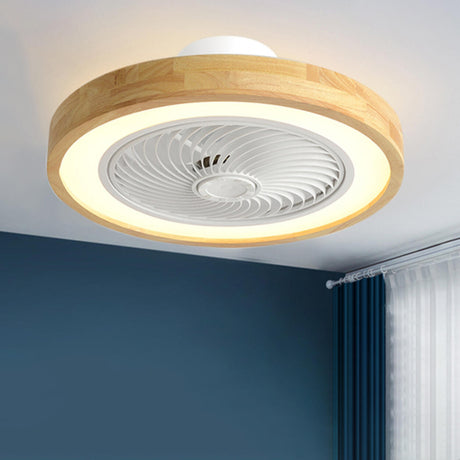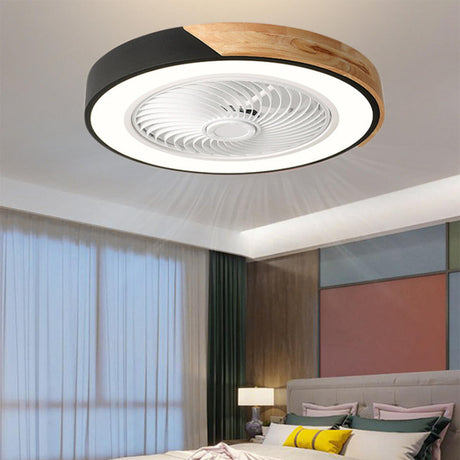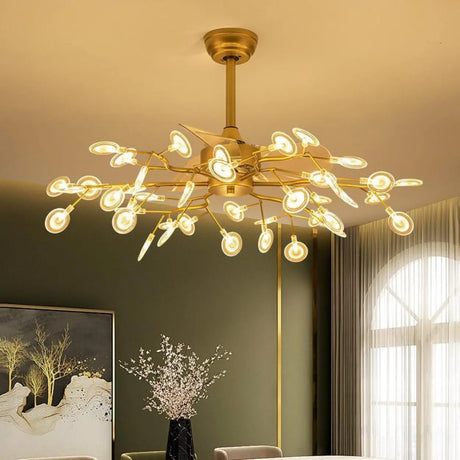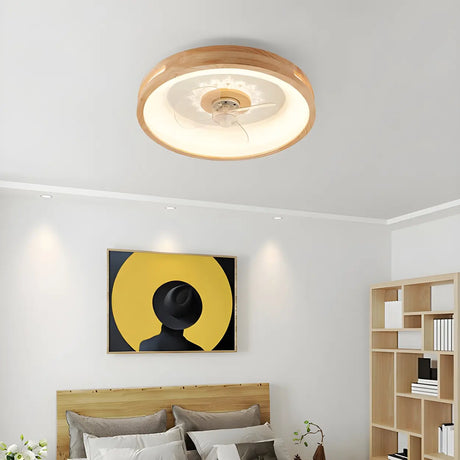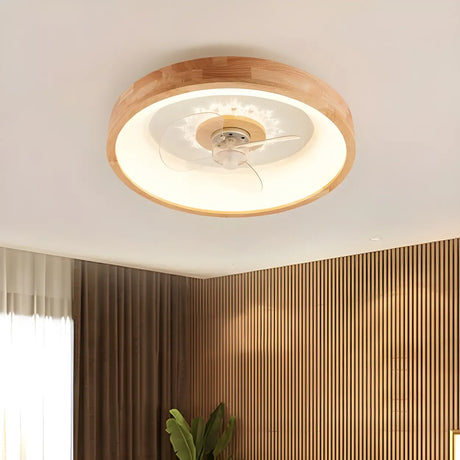When decorating a new home, ceiling fans are almost always a must-have. In recent years, many people have started choosing bladeless options alongside regular blade fans. So which should you pick? Let's look at the differences between bladeless vs regular ceiling fans to help you find the perfect fan for your needs.
Table of Contents
1. What is a Regular Ceiling Fan?

Regular ceiling fans are one of American homes' most common cooling choices. According to the Department of Energy (DOE), over 80% of US households have installed at least one traditional ceiling fan. They work by moving air with rotating blades, helping regulate indoor temperature.
Key advantages
- Budget-friendly, mostly ranging from $100-500.
- Easy to install, as most homes come with pre-installed ceiling fan outlets.
- Blade sizes from 36 to 60 inches, suitable for different room sizes.
- Strong airflow cools the room quickly.
2. What is a Bladeless Ceiling Fan?

Bladeless are newer to the market and hide their blades inside the body, appearing as just a ring or frame. They use a small internal fan to pull in air and shoot it out through tiny slots around the edges, creating airflow.
Key advantages
- Uses air flow technology instead of traditional blades, runs quieter.
- Increased safety - no spinning blades overhead to worry about.
- Easier to clean and maintain - no climbing up to wipe fan blades.
- The airflow is stable, without obvious "gusts", and the distribution is more even.
3. Bladeless VS Normal Ceiling Fans: An In-Depth Comparison
Let's compare these two types of fans from several angles to make the best choice for your needs.
3.1 Working method
A regular ceiling fan works like a boat paddle: as the blades spin, they push air downward. When this air reaches the floor, it creates a cooling circulation pattern in the room. Manufacturers carefully design the blade angles and lengths to move as much air as possible.
Bladeless fans create airflow differently. While it might look magical, the principle is actually quite simple:
- There's a small fan inside the ring.
- This fan pulls air into specially designed channels.
- The channels speed up the airflow before releasing it, like giving the air a "megaphone".
Normal fans work better for cooling large spaces. While bladeless fans provide more even airflow.
3.2 Airflow strength

Traditional and bladeless ceiling fans create airflow in very different ways. Traditional fans directly move the air with their blades, which creates stronger airflow but can sometimes feel too intense. Bladeless fans provide gentler, more even air distribution, making them ideal for people who don't like direct air blasts.
- Traditional fans: Strong airflow that cools rooms quickly.
- Bladeless fans: Gentle, consistent airflow without fluctuations.
Bladeless fans offer infinite adjustment settings for speed control, letting you dial in exactly the airflow you want. Traditional fans typically have only 3-5 speed settings-not as precise, but enough for most homes.
3.3 Noise Levels
Most families care a lot about how loud their ceiling fans are, especially in bedrooms.
Traditional Fans
- Very quiet at low speeds - about 30-35 decibels, like soft whispering.
- Gets noticeably louder as speed increases.
- Can reach 45-50 decibels at high speeds.
Bladeless Fans
- More consistent noise levels.
- Stays around 35-40 decibels at all speeds.
- Quiet enough to run all night while you sleep.
3.4 Safety
Safety is a key factor when you choosing a ceiling fan. While traditional fans are mounted high up, there are still some situations to watch out for:
- Extra care is needed when cleaning or decorating rooms.
- Potential risks for homes with lofts or high ceilings where rotating blades are closer to reach.
- You must ensure the power is completely off when changing light bulbs.
Bladeless fans solve these safety concerns through their innovative design. With no exposed moving parts, they're safer for curious kids and pets who might get too close.
3.5 Cleaning and Maintenance

Regarding daily use, the two types of ceiling fans have their own features.
Regular fans need regular blade cleaning, so climb a ladder to wipe each blade carefully. A thorough cleaning every 2-3 months is recommended.
Maintaining bladeless fans is much simpler. Just wipe the outer surface with a long-handled duster. However, the inside of bladeless fans is difficult to clean.
When it comes to lifespan, traditional fans have proven themselves in the market, typically lasting 15-20 years. Bladeless fans are newer, so their lifespan is still being tested, though most manufacturers offer 10+ year warranties.
3.6 Cost
Buying a ceiling fan is also an investment. Here's what you can expect to pay.
Traditional fans
- Basic models: $100-200 for a good quality fan.
- Mid-range models: $200-400.
- High-end models: $400-800.
Bladeless fans
- Entry-level models: $100-400.
- High-end models: Can exceed $400.
Both types use similar power, around 50-100 watts, for operating costs. However, repair costs differ significantly. Traditional fans have readily available parts and lower repair costs, while bladeless fans often need professional repairs, which can be more expensive.
4. Buying Guide
Let's make choosing a fan easier by looking at what works best in different rooms.
Living Room Choice
A traditional fan makes more sense for living rooms over 200 square feet. It's powerful enough to cool your whole space. However, if looks and quiet operation are your top priorities and you have room in your budget, a bladeless fan could work, too.
Bedroom Choice
Bedrooms and kids rooms need quiet, which is where bladeless fans shine. Their steady noise level and even airflow can help you sleep better. But if you're watching your wallet, a good traditional fan with a remote will do the job just fine.
5. Blade vs Bladeless fan: A Quick Comparison Chart
| Feature | Blade Ceiling Fans | Bladeless Ceiling Fans |
| Coverage Area | 200-250 sq ft | 150-200 sq ft |
| Price Range | $100-800 | $100-1,500 |
| Noise Level | 30-50 dB | 35-40 dB |
| Maintenance | Regular blade cleaning required | Easy surface cleaning |
| Lifespan | 15-20 years | 10+ years |
| Power Usage | 50-100 watts | 50-100 watts |
| Installation | Standard and tall ceiling mount | Standard and short ceiling mount |
| Speed Settings | 3-5 speeds | Variable speed control |
| Safety Features | Basic | Enhanced (no exposed blades) |
| Design Style | Traditional to modern | Contemporary |
Conclusion
In short, a traditional ceiling fan is a reliable choice if you're focused on practicality and budget. But if you want a modern look, easy cleaning, and less noise, go with a bladeless fan.
Remember, picking a fan that fits your real needs is the most important thing. Room size, budget, and how you'll use it are what really matter. Of course, if you still can't choose. Then you can choose to consult professionals, such as Homebaa. We will directly help you choose your ideal ceiling fan.
FAQ
Are bladeless ceiling fans better?
Are bladeless ceiling fans better?
Bladeless ceiling fans offer advantages like quieter operation, easier cleaning, and safer design (no exposed blades), but traditional fans typically provide better airflow and are more energy efficient. "Better" depends on your priorities.
Are bladeless fans more energy efficient than traditional fans?
Are bladeless fans more energy efficient than traditional fans?
No, bladeless fans are generally less energy efficient. They require more power to move the same amount of air as traditional blade fans due to their more complex air multiplication technology.
Do bladeless ceiling fans work?
Do bladeless ceiling fans work?
Yes, they work effectively for air circulation. They use a motor to draw air through the base and amplify it using the Coandă effect, creating smooth airflow throughout the room.
How does a bladeless ceiling fan work?
How does a bladeless ceiling fan work?
A motor draws air through vents in the base, then forces it through a narrow slit around the circular ring. This creates a low-pressure area that pulls surrounding air along with it, amplifying the total airflow.
Are bladeless fans silent?
Are bladeless fans silent?
They're quieter than traditional fans but not completely silent. The motor and air movement still produce some noise, though it's typically a softer, more consistent sound than traditional blade fans.





